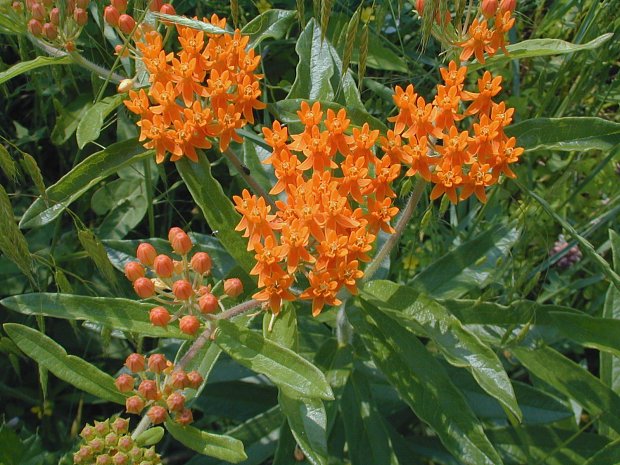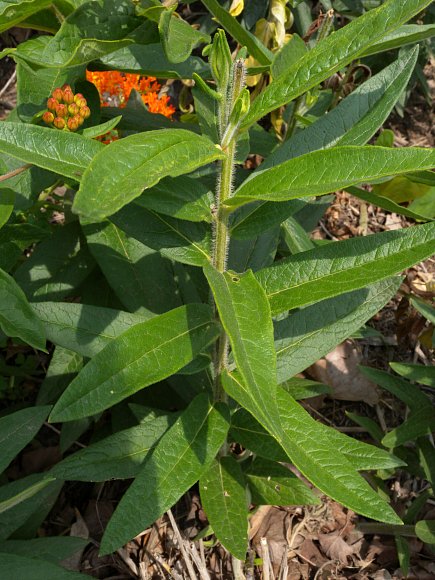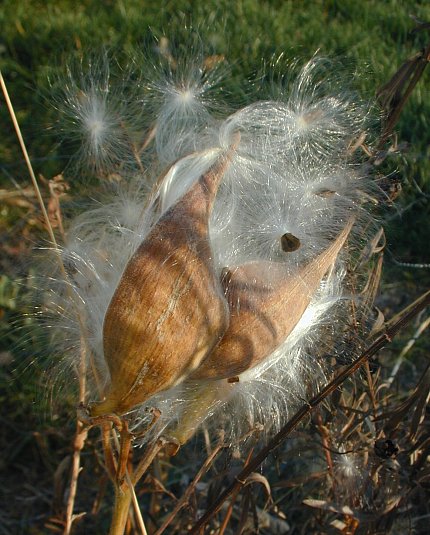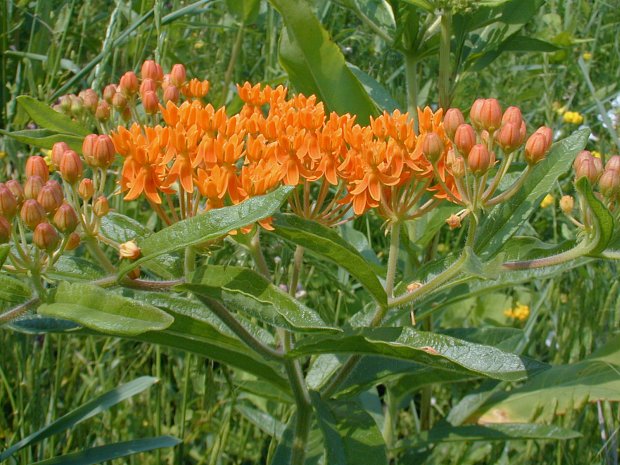Description:
This herbaceous perennial plant is 1-2½' tall. Young plants
develop from a single central stem, while older plants tiller at the
base, sending up multiple erect to ascending stems from a large
taproot. These stems are unbranched below, becoming branched above
where the flowers occur. The stems are light green to dull reddish
purple, terete, and more or less covered with spreading hairs. Densely
distributed along these stems, are alternate leaves that differ little
in size. These leaves are 2½–3½" long and ½–¾" across; they are
linear-oblong to lanceolate-oblong in shape, while their margins are
entire (toothless). The tips of
the leaves are acute, while their bases are slightly cordate, truncate,
or rounded. The leaves are sessile, or they have short petioles up to
3 mm. long. The upper leaf surface is medium to dark green and
glabrous to sparsely short-pubescent, while the lower leaf surface is
light to light-medium green and mostly short-pubescent. Along the lower
sides of the major veins, this pubescence is somewhat longer. The
foliage of this plant lacks a milky latex. Usually several umbels of
flowers develop from the upper stems and the axils of upper leaves.
These umbels span 1–2½" across, consisting of 8-25 flowers each; they
are slightly dome-shaped and often horizontally adjacent to each other.

Each flower consists of 5 sepals, 5 petals, 5 hoods with horns, and a central reproductive column that is white to light green and short. The sepals are light green, hairy, and lanceolate in shape; they are largely hidden when the flowers open. The petals are more or less orange, lanceolate in shape, and declined (bent downward). The hoods are more or less orange, erect, and curved-ovate, forming open oblique tubes. The horns are more or less orange, sickle-shaped, incurved, and exserted from the hoods (one horn per hood). Usually the petals, hoods, and horns are orange, but sometimes they are reddish orange or yellowish orange. The pedicels are ¾–1½" long, light green or light reddish purple, terete, and more or less covered with spreading hairs. At the base of these pedicels, there are several spreading bracts up to 8 mm. long; they are green, linear-lanceolate in shape, and pubescent. The peduncles of the umbels are ½–2½" long, light green to dull reddish purple, terete, and hairy. The flowers bloom during early to mid-summer and sometimes a second time during late summer to early autumn. The flowers are relatively long-lasting, but they have no noticeable fragrance. Flowers that have been successfully cross-pollinated are replaced by follicles (seedpods that open along one side). These follicles are 4-6" long and ½–¾" across at maturity; they are initially light green, but later turn brown. The follicle surface is smooth and short-pubescent. These follicles eventually split open to release their seeds to the wind. Mature seeds are about 4 mm. long, flattened-oval in shape, brown, and narrowly winged along their margins; the apices of these seeds have large tufts of white hair. The root system consists of a woody taproot that is thick and knobby. This taproot can extend several feet below the ground surface.

Cultivation: The preference is full sun, mesic to dry conditions, and an acidic soil that is sandy or rocky. However, this plant will adapt to other kinds of soil, including those that contain loam or clay, if they are well-drained. Although this plant develops somewhat slowly, it is easy to cultivate in open sunny areas once it becomes established. Tolerance to hot dry weather is excellent. If the taproot of a young plant is planted too close to the soil surface, it may become damaged by frost due to heaving of the soil.
Range & Habitat: The native Butterfly Milkweed is occasional to locally common in Illinois, except for the western section of the state, where it is less common (see Distribution Map). Habitats include upland sand prairies, hill prairies, cemetery prairies, sandy savannas, open rocky woodlands, shale and sandstone glades (in southern Illinois), abandoned sandy fields, roadside embankments, and areas along railroads. Because of the showy orange flowers, Butterfly Milkweed is often cultivated in gardens. This milkweed is found in both disturbed areas and high quality natural areas. Occasional wildfires are probably beneficial in maintaining populations of this plant as this reduces competition from woody vegetation and taller herbaceous vegetation.

Faunal Associations: The flower nectar attracts honeybees, digger bees (Melissodes spp.), leaf-cutting bees (Megachile spp.), Halictid bees (including green metallic bees), thread-waisted wasps (Ammophila spp.) and other Sphecid wasps, and butterflies, including Fritillaries (Speyeria spp.), Swallowtails (Papilio spp.), and the Monarch (Danaus plexippus); see Robertson (1929). The Ruby-throated Hummingbird is also attracted to the flowers. Some insects feed destructively on the leaves, flowers and buds, seedpods, and other parts of Butterfly Milkweed. These insects include larvae of the Blackened Milkweed Beetle (Tetraopes melanurus), the Small Milkweed Bug (Lygaeus kalmii), the Large Milkweed Bug (Oncopeltus fasciatus), larvae of a butterfly, the Monarch (Danaus plexippus), and larvae of a moth, the Unexpected Cycnia (Cycnia inopinatus). Butterfly Milkweed is the preferred host plant of the preceding moth (see Yanega, 1996; Betz et al., 1997; Wagner, 2005). A polyphagous insect, the Curve-tailed Bush Katydid (Scudderia curvicauda), was observed to feed on the leaves of this milkweed (Gangwere, 1961); it may also feed on the flowers. While the foliage of Butterfly Milkweed lacks the toxic milky latex that is typical of other milkweeds (Asclepias spp.), mammalian herbivores nonetheless appear to avoid it.

Photographic Location: The above photographs were taken at the webmaster's wildflower garden, Urbana, Illinois, and a flower garden at the Anita Purvis Nature Center of the same city.
Comments: This is perhaps the showiest of the milkweeds (Asclepias spp.) because of the long-lasting and colorful flowers. Because Butterfly Milkweed (Asclepias tuberosa) is the only milkweed in Illinois that has orange flowers, it is easy to identify. This species is also unusual for a milkweed because its leaves are alternate and its foliage lacks a milky latex. Because of the absence of milky latex, it is often referred to as Butterfly Weed, rather than Butterfly Milkweed. The thick and bitter-tasting roots were used for various medicinal purposes in the past, including the treatment of pleurisy. As a result, another common name for this species is Pleurisy Root.

Each flower consists of 5 sepals, 5 petals, 5 hoods with horns, and a central reproductive column that is white to light green and short. The sepals are light green, hairy, and lanceolate in shape; they are largely hidden when the flowers open. The petals are more or less orange, lanceolate in shape, and declined (bent downward). The hoods are more or less orange, erect, and curved-ovate, forming open oblique tubes. The horns are more or less orange, sickle-shaped, incurved, and exserted from the hoods (one horn per hood). Usually the petals, hoods, and horns are orange, but sometimes they are reddish orange or yellowish orange. The pedicels are ¾–1½" long, light green or light reddish purple, terete, and more or less covered with spreading hairs. At the base of these pedicels, there are several spreading bracts up to 8 mm. long; they are green, linear-lanceolate in shape, and pubescent. The peduncles of the umbels are ½–2½" long, light green to dull reddish purple, terete, and hairy. The flowers bloom during early to mid-summer and sometimes a second time during late summer to early autumn. The flowers are relatively long-lasting, but they have no noticeable fragrance. Flowers that have been successfully cross-pollinated are replaced by follicles (seedpods that open along one side). These follicles are 4-6" long and ½–¾" across at maturity; they are initially light green, but later turn brown. The follicle surface is smooth and short-pubescent. These follicles eventually split open to release their seeds to the wind. Mature seeds are about 4 mm. long, flattened-oval in shape, brown, and narrowly winged along their margins; the apices of these seeds have large tufts of white hair. The root system consists of a woody taproot that is thick and knobby. This taproot can extend several feet below the ground surface.

Cultivation: The preference is full sun, mesic to dry conditions, and an acidic soil that is sandy or rocky. However, this plant will adapt to other kinds of soil, including those that contain loam or clay, if they are well-drained. Although this plant develops somewhat slowly, it is easy to cultivate in open sunny areas once it becomes established. Tolerance to hot dry weather is excellent. If the taproot of a young plant is planted too close to the soil surface, it may become damaged by frost due to heaving of the soil.
Range & Habitat: The native Butterfly Milkweed is occasional to locally common in Illinois, except for the western section of the state, where it is less common (see Distribution Map). Habitats include upland sand prairies, hill prairies, cemetery prairies, sandy savannas, open rocky woodlands, shale and sandstone glades (in southern Illinois), abandoned sandy fields, roadside embankments, and areas along railroads. Because of the showy orange flowers, Butterfly Milkweed is often cultivated in gardens. This milkweed is found in both disturbed areas and high quality natural areas. Occasional wildfires are probably beneficial in maintaining populations of this plant as this reduces competition from woody vegetation and taller herbaceous vegetation.

Faunal Associations: The flower nectar attracts honeybees, digger bees (Melissodes spp.), leaf-cutting bees (Megachile spp.), Halictid bees (including green metallic bees), thread-waisted wasps (Ammophila spp.) and other Sphecid wasps, and butterflies, including Fritillaries (Speyeria spp.), Swallowtails (Papilio spp.), and the Monarch (Danaus plexippus); see Robertson (1929). The Ruby-throated Hummingbird is also attracted to the flowers. Some insects feed destructively on the leaves, flowers and buds, seedpods, and other parts of Butterfly Milkweed. These insects include larvae of the Blackened Milkweed Beetle (Tetraopes melanurus), the Small Milkweed Bug (Lygaeus kalmii), the Large Milkweed Bug (Oncopeltus fasciatus), larvae of a butterfly, the Monarch (Danaus plexippus), and larvae of a moth, the Unexpected Cycnia (Cycnia inopinatus). Butterfly Milkweed is the preferred host plant of the preceding moth (see Yanega, 1996; Betz et al., 1997; Wagner, 2005). A polyphagous insect, the Curve-tailed Bush Katydid (Scudderia curvicauda), was observed to feed on the leaves of this milkweed (Gangwere, 1961); it may also feed on the flowers. While the foliage of Butterfly Milkweed lacks the toxic milky latex that is typical of other milkweeds (Asclepias spp.), mammalian herbivores nonetheless appear to avoid it.

Photographic Location: The above photographs were taken at the webmaster's wildflower garden, Urbana, Illinois, and a flower garden at the Anita Purvis Nature Center of the same city.
Comments: This is perhaps the showiest of the milkweeds (Asclepias spp.) because of the long-lasting and colorful flowers. Because Butterfly Milkweed (Asclepias tuberosa) is the only milkweed in Illinois that has orange flowers, it is easy to identify. This species is also unusual for a milkweed because its leaves are alternate and its foliage lacks a milky latex. Because of the absence of milky latex, it is often referred to as Butterfly Weed, rather than Butterfly Milkweed. The thick and bitter-tasting roots were used for various medicinal purposes in the past, including the treatment of pleurisy. As a result, another common name for this species is Pleurisy Root.